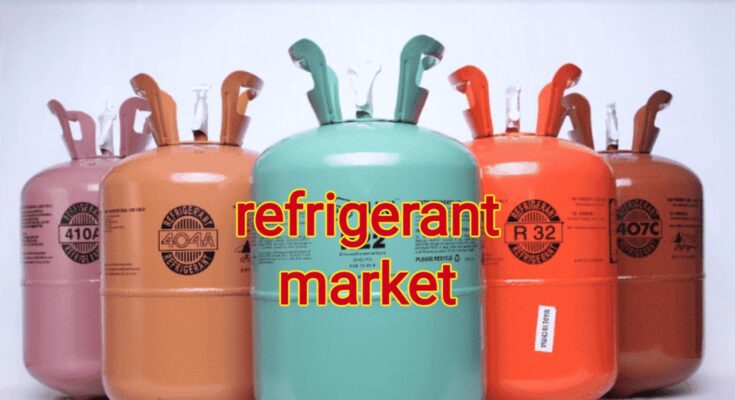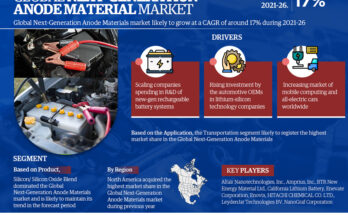Global Refrigerant Market has valued at USD5.46 billion in 2022 and is anticipated to project robust growth in the forecast period with a CAGR of 6.23% through 2028. Refrigerant is a fluid mixture used in heat pump or refrigeration cycles, serving as a coolant. During the refrigeration cycle, it undergoes a phase change from liquid to gas. It is chosen for its non-corrosive nature, high heat vaporization, moderate density in liquid form, and high density in gaseous form. Various chemicals, such as hydrochlorofluorocarbons (HCFC), hydrofluorocarbons (HFC), chlorofluorocarbons (CFC), and other inorganic compounds, are employed as refrigerants.
The demand for air conditioners has surged due to urbanization and improvements in lifestyle, consequently driving the growth of the refrigerant market. Technological advancements and the widespread use of freezing techniques in the food and transportation industries also contribute to this growth. The production of automobiles, which extensively use refrigerants in air conditioning systems, further boosts the demand for refrigerants. Moreover, the increasing production of electric vehicles plays a significant role in energy conservation and fuels the refrigerant market. The commercial sector has also witnessed substantial growth worldwide, with the proliferation of offices, shopping malls, and other infrastructure. These establishments are equipped with heating, ventilation, and air conditioning (HVAC) systems, making refrigerant a crucial component. Thus, the rapid expansion of the commercial sector drives the growth of the refrigerant market. The rise in living standards and per capita income in India has led to changes in individual preferences.
The country is experiencing significant development, accompanied by an increased purchase of health and wellness food products, including organic food that requires cold storage, such as peas, corn, and packaged frozen food items like dairy, baby food, and confectionery products. This trend further contributes to the growth of the refrigerant market. The increasing demand for packaged frozen food presents lucrative opportunities for market expansion.
Key Market Drivers
Growing Demand of Refrigerant in Pharmaceutical Industry
The pharmaceutical industry heavily relies on refrigeration and cooling systems to ensure the integrity, efficacy, and stability of temperature-sensitive products. Vaccines, medications, biologics, and other pharmaceutical products must be stored and transported under specific temperature conditions to maintain their quality and effectiveness. This is particularly critical in scenarios where even slight temperature variations can render products unusable or pose health risks. Pharmaceutical products are subject to rigorous regulatory guidelines that dictate storage and transportation conditions. Organizations such as the World Health Organization (WHO) establish stringent temperature requirements for vaccines and medications to ensure their potency and safety.
The use of refrigerants plays a crucial role in meeting these guidelines, thereby driving demand in the pharmaceutical industry. The distribution of vaccines, especially those requiring ultra-low temperatures, has gained prominence due to global vaccination efforts. The COVID-19 pandemic has highlighted the critical importance of refrigerants in maintaining the cold chain and preserving vaccine efficacy during transport and storage. Furthermore, the pharmaceutical industry is witnessing a surge in the development and production of biologics and specialty drugs.
Download FREE Sample Report @ https://www.techsciresearch.com/report/refrigerant-market/2365.html
These products are often sensitive to temperature and require precise temperature control throughout their lifecycle. Refrigerants play a vital role in providing the necessary cooling for manufacturing, storage, and distribution. Pharmaceutical research and development involve testing and storing samples and compounds under controlled temperature conditions. Refrigerants are essential in maintaining temperature stability in laboratories and research facilities, ensuring the accuracy of experiments and the reliability of results.
Growth in Technological Advancements
As the world strives to achieve a balance between cooling requirements and environmental sustainability, innovations in refrigerant technologies are shaping the industry landscape. Technological advancements have optimized cooling system designs and components, resulting in enhanced energy efficiency. Improved compressor technologies, advanced heat exchangers, and optimized system controls contribute to systems that deliver equivalent or superior cooling performance while consuming less energy. Intelligent sensors, real-time monitoring, and data analytics enable remote diagnostics, predictive maintenance, and system performance optimization. This not only enhances efficiency but also reduces downtime and operational costs. Cryogenic technologies are advancing the possibilities of refrigerant applications. Cryogenic refrigerants like liquid nitrogen and helium find applications in medical, research, and industrial processes. Furthermore, emerging applications such as magnetic refrigeration, which relies on solid-state materials and magnetic fields, are being explored for their potential to revolutionize cooling technology. Innovative refrigerant blending techniques are generating solutions that combine the advantages of multiple refrigerants. Blends with improved thermodynamic properties, efficiency, and safety are being developed to address specific industry needs while minimizing environmental impact. Heat pumps are gaining momentum as energy-efficient solutions for both heating and cooling. Technological advancements have led to the creation of high-performance heat pumps that leverage natural refrigerants and improved heat transfer mechanisms. Moreover, innovative technologies are being researched to capture and utilize carbon dioxide (CO2) emissions as a refrigerant, offering a dual benefit of mitigating carbon emissions and providing a viable and eco-friendly refrigerant option. Technological advancements in manufacturing processes are reducing production costs and enabling the production of complex refrigerant components with precision. Advanced manufacturing techniques like additive manufacturing are enhancing flexibility and customization in system design.
Key Market Challenges
Flammability and Safety Concerns
The global refrigerants market is undergoing a transformative shift driven by environmental considerations and regulatory changes. As the industry transitions to more environmentally friendly options, one of the significant challenges that manufacturers and stakeholders face is the flammability and safety concerns associated with some alternative refrigerants. While traditional synthetic refrigerants like hydrochlorofluorocarbons (HCFCs) and hydrofluorocarbons (HFCs) are non-flammable, many of the alternatives, including natural refrigerants and hydrocarbon-based refrigerants, possess varying degrees of flammability. Leakages, improper installation, or equipment malfunctions can potentially lead to flammable gas concentrations in confined spaces, increasing the risk of fire or explosion. The utilization of flammable refrigerants requires adjustments to equipment, components, and system designs to guarantee safe operation. Incorporating these refrigerants into existing systems or designing new ones to accommodate them introduces intricacy and incurs additional costs to the process. The safe handling and maintenance of systems using flammable refrigerants require specialized training and expertise. Technicians and operators must be well-versed in the characteristics of these refrigerants, proper procedures, and safety precautions.
Transition to Low-GWP Alternatives
One of the key challenges in transitioning to low-GWP alternatives is ensuring their technical compatibility with existing equipment and systems. Retrofitting or replacing refrigeration and air conditioning systems to accommodate new refrigerants can be a complex and costly endeavor. Achieving optimal system performance, efficiency, and safety with low-GWP refrigerants requires thorough engineering and design considerations. The availability of low-GWP refrigerants may be limited, particularly in regions where the infrastructure for production, distribution, and storage is not fully developed. This limited availability can impact the pace of transition, leading to market imbalances that affect costs and access for various stakeholders. Moreover, the transition to low-GWP alternatives demands specialized knowledge and technical expertise. Engineers, technicians, and professionals need to receive training in the proper handling, installation, and maintenance of these refrigerants. The availability of skilled personnel to manage these transitions can pose a challenge in certain regions.
Key Market Trends
Growing Demand for Natural Refrigerants
The refrigerants market is currently experiencing a significant transformation, driven by the increasing demand for natural refrigerants. These environmentally friendly alternatives offer a sustainable solution to synthetic refrigerants with high global warming potential (GWP). Natural refrigerants, such as carbon dioxide (CO2 or R-744), ammonia (NH3 or R-717), hydrocarbons (HCs), and water, are naturally occurring substances that can be utilized for cooling purposes in refrigeration and air conditioning systems. Their low or zero GWP makes them a viable choice for mitigating the environmental impact associated with traditional synthetic refrigerants. The demand for natural refrigerants is primarily fueled by the urgent need to address the environmental consequences of synthetic refrigerants, particularly hydrofluorocarbons (HFCs), which have a high GWP and contribute significantly to global warming. In contrast, natural refrigerants have minimal to no impact on the environment, making them an effective solution to combat climate change. Strict regulations and international agreements, such as the Kigali Amendment to the Montreal Protocol, are driving global efforts to phase out high-GWP synthetic refrigerants. Industries are thus actively seeking alternative refrigerants with lower GWP to ensure compliance with evolving regulations. In addition to their environmental benefits, natural refrigerants offer excellent thermodynamic properties that can result in more energy-efficient cooling systems. Technological advancements and improved engineering practices have made it increasingly feasible to use natural refrigerants in a wider range of applications. Innovations in system design, component materials, and safety measures have further contributed to the expanded adoption of natural refrigerants.
Segmental Insights
Type Insights
In 2022, the refrigerant market was dominated by the fluorocarbons and is predicted to continue expanding over the coming years. Halocarbons are fluorinated aliphatic chemical derivatives of saturated hydrocarbons that are widely used in domestic and industrial refrigeration systems. These include HFCs, HCFCs, and CFCs. The molecular structure of halocarbons consists of halogen atoms such as carbon, fluorine, hydrogen, chlorine, or bromine. Halocarbons are considered specialty chemicals with significant applications in refrigeration and air conditioning units. The Asia-Pacific region, particularly China and India, has witnessed a notable increase in demand for refrigerants. This can be attributed to the rise in per capita income and the development of domestic standards and automobile industries.
Application Insights
In 2022, the refrigerants market was dominated by refrigeration system segment and is predicted to continue expanding over the coming years. Refrigerants play a crucial role in the functioning of refrigeration and air conditioning systems, and the widespread use of refrigerators, particularly in households and commercial spaces, contributes to their dominance in the market. Rapid urbanization, population growth, and changing lifestyles have led to increased demand for convenience and food preservation. This has translated into higher demand for refrigeration units like refrigerators and freezers in both residential and commercial settings. Energy efficiency has become a critical consideration for both manufacturers and consumers. Refrigerators are under scrutiny to meet energy efficiency standards and regulations set by governments and environmental organizations. The choice of refrigerant significantly influences the energy efficiency of these appliances. Retrofitting existing refrigeration systems and appliances with newer, low-GWP refrigerants is a common practice to extend the life of older units and improve their environmental performance.
Related Reports
Polyetheramine Market [2028]: Analysis & Forecast
Sorbitol Market – Opportunities, Size & Growth [2028]
Table of Content-Refrigerant Market
- Product Overview
1.1. Market Definition
1.2. Scope of the Market
1.2.1. Markets Covered
1.2.2. Years Considered for Study
1.2.3. Key Market Segmentations
- Research Methodology
2.1. Objective of the Study
2.2. Baseline Methodology
2.3. Key Industry Partners
2.4. Major Association and Secondary Sources
2.5. Forecasting Methodology
2.6. Data Triangulation & Validation
2.7. Assumptions and Limitations
- Executive Summary
3.1. Overview of the Market
3.2. Overview of Key Market Segmentations
3.3. Overview of Key Market Players
3.4. Overview of Key Regions/Countries
3.5. Overview of Market Drivers, Challenges, Trends
- Voice of Customer
- Global Refrigerant Market Outlook
5.1. Market Size & Forecast
5.1.1. By Value & Volume
5.2. Market Share & Forecast
5.2.1. By Type (Fluorocarbons, Hydrocarbons, Inorganic Refrigerants, Others)
5.2.2. By Application (Refrigeration System, Chillers, Air Conditioning Systems, Others)
5.2.3. By Company (2022)
5.2.4. By Region
5.3. Product Market Map
- North America Refrigerant Market Outlook
6.1. Market Size & Forecast
6.1.1. By Value & Volume
6.2. Market Share & Forecast
6.2.1. By Type
6.2.2. By Application
6.2.3. By Country
6.3. North America: Country Analysis
6.3.1. United States Refrigerant Market Outlook
6.3.1.1. Market Size & Forecast
6.3.1.1.1. By Value & Volume
6.3.1.2. Market Share & Forecast
6.3.1.2.1. By Type
6.3.1.2.2. By Application
6.3.2. Mexico Refrigerant Market Outlook
6.3.2.1. Market Size & Forecast
6.3.2.1.1. By Value & Volume
6.3.2.2. Market Share & Forecast
6.3.2.2.1. By Type
6.3.2.2.2. By Application
6.3.3. Canada Refrigerant Market Outlook
6.3.3.1. Market Size & Forecast
6.3.3.1.1. By Value & Volume
6.3.3.2. Market Share & Forecast
6.3.3.2.1. By Type
6.3.3.2.2. By Application
- Europe Refrigerant Market Outlook
7.1. Market Size & Forecast
7.1.1. By Value & Volume
7.2. Market Share & Forecast
7.2.1. By Type
7.2.2. By Application
7.2.3. By Country
7.3. Europe: Country Analysis
7.3.1. France Refrigerant Market Outlook
7.3.1.1. Market Size & Forecast
7.3.1.1.1. By Value & Volume
7.3.1.2. Market Share & Forecast
7.3.1.2.1. By Type
7.3.1.2.2. By Application
7.3.2. Germany Refrigerant Market Outlook
7.3.2.1. Market Size & Forecast
7.3.2.1.1. By Value & Volume
7.3.2.2. Market Share & Forecast
7.3.2.2.1. By Type
7.3.2.2.2. By Application
7.3.3. United Kingdom Refrigerant Market Outlook
7.3.3.1. Market Size & Forecast
7.3.3.1.1. By Value & Volume
7.3.3.2. Market Share & Forecast
7.3.3.2.1. By Type
7.3.3.2.2. By Application
7.3.4. Italy Refrigerant Market Outlook
7.3.4.1. Market Size & Forecast
7.3.4.1.1. By Value & Volume
7.3.4.2. Market Share & Forecast
7.3.4.2.1. By Type
7.3.4.2.2. By Application
7.3.5. Spain Refrigerant Market Outlook
7.3.5.1. Market Size & Forecast
7.3.5.1.1. By Value & Volume
7.3.5.2. Market Share & Forecast
7.3.5.2.1. By Type
7.3.5.2.2. By Application
- Asia-Pacific Refrigerant Market Outlook
8.1. Market Size & Forecast
8.1.1. By Value & Volume
8.2. Market Share & Forecast
8.2.1. By Type
8.2.2. By Application
8.2.3. By Country
8.3. Asia-Pacific: Country Analysis
8.3.1. China Refrigerant Market Outlook
8.3.1.1. Market Size & Forecast
8.3.1.1.1. By Value & Volume
8.3.1.2. Market Share & Forecast
8.3.1.2.1. By Type
8.3.1.2.2. By Application
8.3.2. India Refrigerant Market Outlook
8.3.2.1. Market Size & Forecast
8.3.2.1.1. By Value & Volume
8.3.2.2. Market Share & Forecast
8.3.2.2.1. By Type
8.3.2.2.2. By Application
8.3.3. South Korea Refrigerant Market Outlook
8.3.3.1. Market Size & Forecast
8.3.3.1.1. By Value & Volume
8.3.3.2. Market Share & Forecast
8.3.3.2.1. By Type
8.3.3.2.2. By Application
8.3.4. Japan Refrigerant Market Outlook
8.3.4.1. Market Size & Forecast
8.3.4.1.1. By Value & Volume
8.3.4.2. Market Share & Forecast
8.3.4.2.1. By Type
8.3.4.2.2. By Application
8.3.5. Australia Refrigerant Market Outlook
8.3.5.1. Market Size & Forecast
8.3.5.1.1. By Value & Volume
8.3.5.2. Market Share & Forecast
8.3.5.2.1. By Type
8.3.5.2.2. By Application
- South America Refrigerant Market Outlook
9.1. Market Size & Forecast
9.1.1. By Value & Volume
9.2. Market Share & Forecast
9.2.1. By Type
9.2.2. By Application
9.2.3. By Country
9.3. South America: Country Analysis
9.3.1. Brazil Refrigerant Market Outlook
9.3.1.1. Market Size & Forecast
9.3.1.1.1. By Value & Volume
9.3.1.2. Market Share & Forecast
9.3.1.2.1. By Type
9.3.1.2.2. By Application
9.3.2. Argentina Refrigerant Market Outlook
9.3.2.1. Market Size & Forecast
9.3.2.1.1. By Value & Volume
9.3.2.2. Market Share & Forecast
9.3.2.2.1. By Type
9.3.2.2.2. By Application
9.3.3. Colombia Refrigerant Market Outlook
9.3.3.1. Market Size & Forecast
9.3.3.1.1. By Value & Volume
9.3.3.2. Market Share & Forecast
9.3.3.2.1. By Type
9.3.3.2.2. By Application



